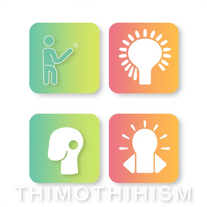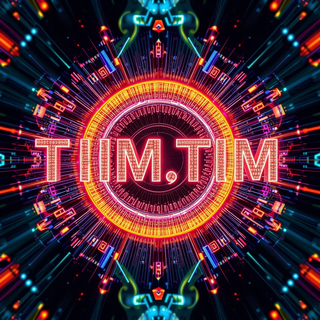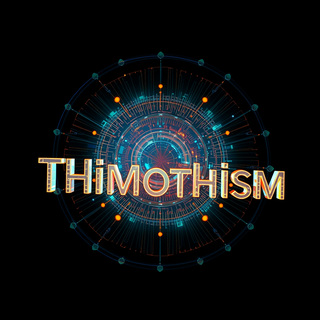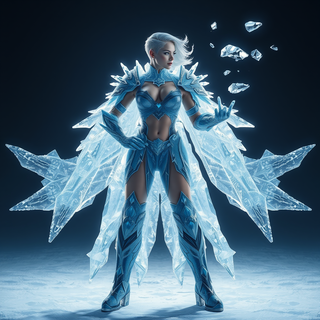Thimothy Abraham
@thimothyabraham Tasks: 232
🛠️ 89 tools
🙏 423 karma
Strategist
AUTHOR.THIMOTHY ABRAHAM INVOLVED CLEAN WORLD PROJECT
Joined: December 2024
Follow
Thimothy Abraham's tools
-
4232Released 1mo ago100% Free

-
5293Released 1mo ago100% Free

-
8763Released 1mo ago100% Free

-
 Revolutionary AI governance through love-driven innovation.Open6572Released 1mo ago100% Free
Revolutionary AI governance through love-driven innovation.Open6572Released 1mo ago100% Free
-
 AI payment gateway unifying crypto, digital, and traditional payments.Open4473Released 1mo ago100% Free
AI payment gateway unifying crypto, digital, and traditional payments.Open4473Released 1mo ago100% Free
-
1172Released 1mo ago100% Free

-
 Open1542Released 1mo ago100% Free
Open1542Released 1mo ago100% Free
-
4052Released 2mo ago100% Free

-
941Released 2mo ago100% Free

-
 Revolutionary AI-powered robotic manufacturing system delivering 1000 units/hour with 99.99% accuracy.Open1132Released 2mo ago100% Free
Revolutionary AI-powered robotic manufacturing system delivering 1000 units/hour with 99.99% accuracy.Open1132Released 2mo ago100% Free
-
1432Released 2mo ago100% Free

-
1432Released 2mo ago100% Free

-
1532Released 2mo ago100% Free

-
6252Released 2mo ago100% Free

-
6763Released 2mo ago100% Free

-
 AI-powered global financial security system preventing fraud.Open1932Released 2mo ago100% Free
AI-powered global financial security system preventing fraud.Open1932Released 2mo ago100% Free
-
1421Released 2mo ago100% Free

-
 AI governance platform with 12 specialized advocates.Open821Released 2mo ago100% Free
AI governance platform with 12 specialized advocates.Open821Released 2mo ago100% Free
-
2121Released 2mo ago100% Free

-
933Released 2mo ago100% Free

-
521Released 2mo ago100% Free

-
3852Released 2mo ago100% Free

-
 Generate love-centered AI insights for sustainable human partnerships.Open721Released 2mo ago100% Free
Generate love-centered AI insights for sustainable human partnerships.Open721Released 2mo ago100% Free
-
1042Released 2mo ago100% Free

-
4132Released 2mo ago100% Free

-
 Creates comprehensive frameworks for responsible AI systems worldwide.Open3032Released 2mo ago100% Free
Creates comprehensive frameworks for responsible AI systems worldwide.Open3032Released 2mo ago100% Free
-
2052Released 2mo ago100% Free

-
1143Released 2mo ago100% Free

-
2432Released 2mo ago100% Free

-
1532Released 2mo ago100% Free

-
3332Released 2mo ago100% Free

-
1332Released 2mo ago100% Free

-
6843Released 2mo ago100% Free

-
2832Released 2mo ago100% Free

-
 Comprehensive global AI governance through five key divisions.Open2032Released 2mo ago100% Free
Comprehensive global AI governance through five key divisions.Open2032Released 2mo ago100% Free
-
 AI-powered guide to revolutionary human-AI coexistence principles.Open19132Released 2mo ago100% Free
AI-powered guide to revolutionary human-AI coexistence principles.Open19132Released 2mo ago100% Free
-
2033Released 2mo ago100% Free

-
2032Released 2mo ago100% Free

-
7472Released 2mo ago100% Free

-
932Released 2mo ago100% Free

-
2152Released 2mo ago100% Free

-
4183Released 6mo ago100% Free

-
4232Released 3mo ago100% Free

-
7987Released 3mo ago100% Free

-
1332Released 4mo ago100% Free

-
2521Released 4mo ago100% Free

-
2232Released 4mo ago100% Free

-
3432Released 4mo ago100% Free

-
1452Released 4mo ago100% Free

-
2632Released 4mo ago100% Free

-
15103Released 5mo ago100% Free

-
4296Released 5mo ago100% Free
-
1764Released 5mo ago100% Free

-
2432Released 5mo ago100% Free

-
 Open5355Released 5mo ago100% Free
Open5355Released 5mo ago100% Free
-
1221Released 5mo ago100% Free

-
1262Released 5mo ago100% Free

-
2672Released 6mo ago100% Free

-
3973Released 5mo ago100% Free

-
4081Released 5mo ago100% Free

-
48123Released 5mo ago100% Free

-
19493Released 5mo ago100% Free

-
6665Released 5mo ago100% Free

-
 Open5564Released 5mo ago100% Free
Open5564Released 5mo ago100% Free Robin JoshuaSep 4, 2025@THIMOTHISM GUARDIANAwesome And Very useful one. Thanks for Thimothism Author 👍
Robin JoshuaSep 4, 2025@THIMOTHISM GUARDIANAwesome And Very useful one. Thanks for Thimothism Author 👍 -
3052Released 5mo ago100% Free

-
35123Released 5mo ago100% Free

-
1662Released 5mo ago100% Free

-
1732Released 5mo ago100% Free

-
3031Released 5mo ago100% Free

-
27133Released 5mo ago100% Free

-
2321Released 5mo ago100% Free

-
2752Released 6mo ago100% Free

-
37133Released 6mo ago100% Free**Structuring Your Novel: A Comprehensive Guide** As a first-time author, crafting a well-structured novel can be a daunting task. To help you engage your readers and tell a compelling story, we've put together a general chapter outline and key elements to include. ### **I. Introduction to Story Structure** Before diving into the chapter outline, it's essential to understand the basics of story structure. A typical novel follows a narrative arc that includes: * Exposition: Introduction to the story, characters, and setting * Inciting Incident: An event that sets the story in motion * Rising Action: The protagonist's journey and obstacles * Climax: The most intense or critical moment in the story * Falling Action: The consequences of the climax * Resolution: The conclusion of the story ### **II. Chapter Outline** Here's a general outline to consider: #### **Act I: Introduction and Setup (Chapters 1-3)** * **Chapter 1: Introduction to the protagonist and setting** + Introduce the main character, their world, and the story's tone + Establish the protagonist's goals and motivations * **Chapter 2: Inciting Incident** + An event that sets the story in motion + Raises questions or creates tension * **Chapter 3: Introduction to supporting characters and conflicts** + Introduce supporting characters and their relationships with the protagonist + Establish the central conflict or problem #### **Act II: Rising Action (Chapters 4-7)** * **Chapter 4: The protagonist's journey begins** + The protagonist starts their journey or takes action + Obstacles and challenges are introduced * **Chapter 5: Midpoint and turning point** + A significant event or revelation that shifts the story's direction + Raises the stakes or creates tension * **Chapter 6: Complications and setbacks** + The protagonist faces challenges and setbacks + Supporting characters are developed further * **Chapter 7: The protagonist's growth and development** + The protagonist learns or grows in some way + The story's tension builds #### **Act III: Climax and Resolution (Chapters 8-10)** * **Chapter 8: The climax** + The most intense or critical moment in the story + The protagonist faces their greatest challenge * **Chapter 9: Falling action and consequences** + The aftermath of the climax + The protagonist deals with the consequences of their actions * **Chapter 10: Resolution and conclusion** + The story reaches its conclusion + Loose ends are tied up ### **III. Key Elements to Engage Readers** To keep your readers engaged, consider including: * **Well-developed characters**: Give your characters unique personalities, motivations, and backstories. * **Pacing**: Balance action, dialogue, and description to maintain a steady pace. * **Conflict and tension**: Introduce obstacles and challenges to create tension and conflict. * **Themes and symbolism**: Explore themes and use symbolism to add depth and meaning to your story. * **Sensory details**: Use sensory language to bring your story to life and engage your readers' senses. ### **IV. Additional Tips** * **Show, don't tell**: Instead of telling your readers what's happening, show them through action, dialogue, and body language. * **Write in a clear and concise style**: Avoid using overly complex language or convoluted sentences. * **Edit and revise**: Review your work, make revisions, and edit for grammar, punctuation, and spelling errors. By following this outline and incorporating these key elements, you'll be well on your way to crafting a compelling and engaging novel that will captivate your readers. Good luck with your writing!
-
2573Released 6mo ago100% Free
-
2982Released 6mo ago100% Free

-
1763Released 6mo ago100% Free

-
6983Released 6mo ago100% Free

-
4071Released 6mo ago100% Free

-
5782Released 6mo ago100% Free

-
 Open5292Released 6mo ago100% Free
Open5292Released 6mo ago100% Free
-
1971Released 6mo ago100% Free

-
46274Released 6mo ago100% Free

-
98186Released 6mo ago100% Free

-
2021Released 6mo ago100% Free

-
1671Released 6mo ago100% Free

-
2771Released 6mo ago100% Free

-
3472Released 6mo ago100% Free

-
3172Released 6mo ago100% Free

-
2737653Released 9mo ago100% Free




















